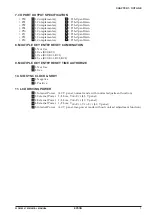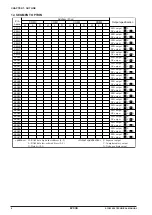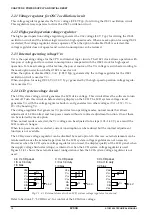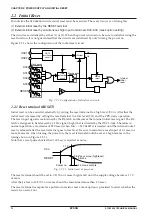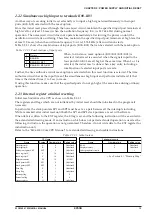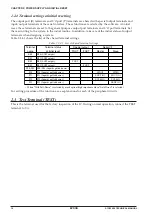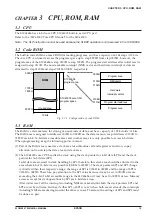
S1C63656 TECHNICAL MANUAL
EPSON
1
CHAPTER 1: OUTLINE
CHAPTER
1 O
UTLINE
The S1C63656 is a microcomputer which has a high-performance 4-bit CPU S1C63000 as the core CPU,
ROM (6,144 words
×
13 bits), RAM (1,024 words
×
4 bits), multiply-divide circuit, serial interface, watchdog
timer, programmable timer, time base counters (2 systems), an LCD driver that can drive a maximum 38
segments
×
4 commons, sound generator, R/f converter and stepping motor driver built-in. The S1C63656
features low current consumption, this makes it suitable for battery driven clocks and watches with tempera-
ture and humidity measurement functions.
1.1 Features
OSC1 oscillation circuit ......................
32.768 kHz (Typ.) crystal oscillation circuit
OSC3 oscillation circuit ......................
4 MHz (Max.) ceramic (2 MHz Max. when OSC3 is used as the R/f
converter operating clock),
1.1 MHz (Typ.) CR oscillation circuit
or not used (
∗
1)
Instruction set .....................................
Basic instruction: 46 types (411 instructions with all)
Addressing mode: 8 types
Instruction execution time ...................
During operation at 32.768 kHz: 61 µsec 122 µsec 183 µsec
During operation at 4 MHz:
0.5 µsec
1 µsec
1.5 µsec
ROM capacity .....................................
Code ROM:
6,144 words
×
13 bits
Data ROM:
1,024 words
×
4 bits
RAM capacity ......................................
Data memory:
1,024 words
×
4 bits
Display memory: 48 words
×
4 bits
Input port .............................................
8 bits (Pull-down resistors may be supplemented
∗
1)
Output port ..........................................
4 bits (It is possible to switch the 2 bits to special output
∗
2)
I/O port ................................................
8 bits (It is possible to switch the 4 bits to serial I/F input/output
∗
2)
Serial interface ....................................
1 port (8-bit clock synchronous system)
LCD driver ...........................................
38 segments
×
4 or 3 commons (
∗
2)
Time base counter ..............................
Clock timer
Stopwatch timer (1/1000 sec, with direct key input function)
Programmable timer ...........................
8-bit PWM
×
2 ch. or 16-bit PWM
×
1 ch. (
∗
2)
Watchdog timer ...................................
Built-in
Sound generator .................................
With envelope and 1-shot output functions
R/f converter .......................................
2 ch., CR oscillation type, 20-bit counter
Supports resistive humidity sensors
Multiply-divide circuit ..........................
8-bit accumulator
×
1 ch.
Multiplication: 8 bits
×
8 bits
→
16-bit product
Division:
16 bits
÷
8 bits
→
8-bit quotient and 8-bit remainder
Stepping motor driver .........................
2 ch., a clock or watch controller can be implemented
Supply voltage detection (SVD) circuit ..
Criteria voltages: 1.85–2.90 V (1.13–1.64 V when OSC3 is not used)
are selectable (
∗
2)
External interrupt ................................
Input port interrupt:
2 systems
Internal interrupt .................................
Clock timer interrupt:
5 systems
Stopwatch timer interrupt:
4 systems
Programmable timer interrupt: 4 systems
Serial interface interrupt:
1 system
R/f converter interrupt:
2 systems
Motor driver interrupt:
2 systems
Power supply voltage ..........................
2.4 to 3.6 V: Max. 4 MHz operation (when OSC3 is used)
1.1 to 3.6 V: 32 kHz operation (when OSC3 is not used)
Operating temperature range .............
-20 to 70°C
Current consumption (Typ.) ................
Low-speed operation (OSC1 = 32 kHz crystal oscillation):
During HALT
3.0 V (LCD ON)
0.60 µA
During operation
3.0 V (LCD ON)
2.50 µA
High-speed operation (OSC3 ceramic oscillation):
During operation
3.0 V (LCD ON)
1.0 mA
Package ..............................................
QFP20-144pin (plastic) or chip
∗
1: Can be selected with mask option
∗
2: Can be selected with software

















